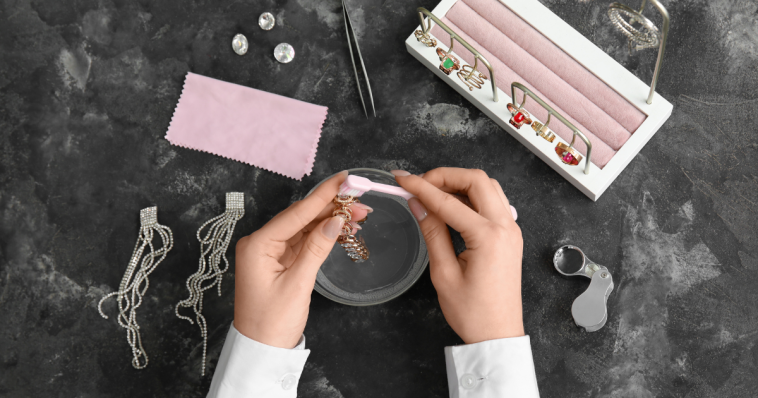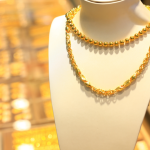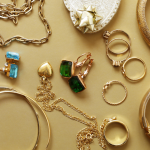Restoring rusted jewelry is easier than you might think. You can effectively clean and refresh your jewelry with everyday household items and essential tools. This guide provides the best jewelry guide and gentle methods to restore the brilliance of your rings, necklaces, and bracelets. Additionally, tips on preventing future rust are provided to keep jewelry looking stunning for years. Clear instructions ensure confidence in restoring and maintaining pieces.
Factors Leading to Rust on Jewelry
Understanding the factors leading to rust on jewelry is crucial for adequate care. Rust forms on metals containing iron, such as steel, iron, or brass. While gold, silver, platinum, and titanium are typically rust-resistant because they lack iron, some jewelry pieces may include iron-based alloys or plating that can rust over time. This knowledge empowers you to care for your jewelry better and prevent rust from affecting your cherished pieces.
- Moisture and Oxygen: Moisture and oxygen are key culprits in rusting. When exposed to water or high humidity, the metal reacts with oxygen, forming iron oxide or rust. These elements create the perfect conditions for corrosion, accelerating the rusting of your jewelry. Moisture sources such as sweat, rain, showering, swimming, and accidental spills can significantly speed up rusting. These common exposures can prevent jewelry from becoming dull and damaged if appropriately managed.
- Pollution: Pollution greatly accelerates rusting by introducing corrosive elements into the environment. When airborne pollutants mix with moisture, they form acids that aggressively attack and corrode metal surfaces. Familiar sources of pollution, including car exhaust, industrial emissions, and cigarette smoke, further enhance this corrosion process. These pollutants create an aggressive environment, increasing rusting and damaging your jewelry.
- Low-Quality Materials and Plating: Low-quality metals are more susceptible to rust because they often have higher iron content or thin, less protective plating. These factors accelerate corrosion, leading to rust and deterioration over time. In contrast, high-quality metals, such as those used in 925 sterling silver jewelry, are less prone to rust. They are formulated with lower iron content and feature thicker plating, providing superior rust resistance and extending the jewelry’s lifespan.
- Lack of Maintenance: Skipping regular maintenance can lead to rust. Dirt, dust, and oil buildup can create conditions that encourage rust formation. Additionally, improper storage—such as exposing jewelry to moisture, oxygen, or pollution—can further accelerate rusting. These factors underscore the need for consistent care and maintenance to prevent corrosion and extend the life of your jewelry. Proper upkeep helps ensure your pieces remain beautiful and in good condition.
Best Jewelry Guide: Tips to Prevent and Clean Rust Effectively
How to Prevent Rust on Your Jewelry
To keep your jewelry from rusting, follow these practical tips:
- Regular Maintenance: To prevent rust, clean your jewelry regularly—ideally once a month or more often if worn frequently. Use suitable cleaning methods or a mild jewelry cleaner, and check for any signs of rust or damage. Address any rust immediately to prevent it from spreading or worsening.
- Storage: To keep your jewelry rust-free, store it in a cool, dry, dark spot, like a jewelry box or pouch. Avoid metals or materials that rust easily, such as iron or leather. Also, avoid places prone to moisture or pollution, like bathrooms or kitchens.
- Keep Away From Water: Water speeds up rust formation, so remove your jewelry before swimming, showering, working out, or applying lotions, perfumes, or makeup. After wearing your jewelry, gently wipe it with a soft cloth to remove sweat and residue.
- Use Gel Packs: Silica gel packs effectively absorb moisture and prevent rust. Keep them in your jewelry storage to reduce humidity. To keep them effective, replace the packs every few months or when they become saturated.
Cleaning Tips for Rusted Jewelry
1. Arrange Necessary Ingredients
To effectively clean rusted jewelry, gather the following ingredients: baking soda, a gentle abrasive that removes rust; white vinegar, which dissolves rust and restores color; and dish soap, which eliminates grease and oils. Lemon juice can brighten the jewelry and assist in rust removal, while salt is a mild abrasive that helps prevent future rust. When used in the right combination, these ingredients are highly effective in restoring your jewelry to its original shine, giving you confidence in the restoration process. Each ingredient is essential in cleaning, and when combined, they can restore your jewelry’s shine and integrity. By harnessing their combined properties, you can effectively address stubborn rust and keep your cherished pieces looking their best.
2. Prepare Necessary Tools
Gather the essential tools for cleaning your jewelry effectively: a soft, clean toothbrush for gently scrubbing and reaching into intricate crevices. A toothbrush’s soft bristles are ideal for cleaning jewelry as they are gentle enough to avoid scratching the metal or stones yet firm enough to remove dirt and rust. Also, a small container for soaking the pieces and a smooth, lint-free cloth for drying and polishing. These tools are critical to a thorough cleaning process. The toothbrush tackles rust and dirt in detailed areas, the container ensures even soaking, and the lint-free cloth is essential for drying and achieving a polished, streak-free finish.
3. Make a Baking Soda Solution
Mix one cup of water with a tablespoon of baking soda to form a thick paste. This paste will effectively adhere to and treat rust on your jewelry. The baking soda solution loosens and lifts rust from your jewelry’s surface. Its gentle abrasive properties make it a practical yet mild cleaner, helping to restore your pieces to their original shine.
4. Apply the Solution
Use a toothbrush to apply the baking soda solution to your jewelry, scrubbing gently to ensure you cover all areas, including intricate details. This will help remove rust and grime effectively. For better results, consider adding lemon juice or salt to the solution. These ingredients can enhance the cleaning power, helping to tackle stubborn rust spots and improve the overall cleanliness of your jewelry.
5. Let the Solution Sit
Let the jewelry soak in the solution for 15 to 30 minutes, giving it time to loosen the rust. Periodically check the jewelry and gently scrub it if needed to help remove any stubborn rust. Regularly inspect the jewelry to ensure the solution effectively addresses the rust buildup. Adjust the soaking time and scrubbing as needed to achieve the best results and restore your jewelry to its original condition.
6. Rinse the Jewelry
After removing the jewelry from the baking soda solution, rinse it thoroughly under clean, running water. Use a container or sink to ensure that all baking soda residue is thoroughly washed away. Ensure the water is at a moderate temperature—neither too hot nor too cold—and rinse the jewelry thoroughly until all traces of the solution are removed. Proper rinsing is essential to prevent leftover baking soda from affecting the jewelry’s appearance or causing further tarnishing.
7. Soak in White Vinegar Solution
Combine one part white vinegar with two parts water to create a cleaning solution. Soak your jewelry in this mixture for 15 to 30 minutes to help dissolve any remaining rust and restore its original color. As the jewelry soaks, the white vinegar will break down rust and improve its appearance. Monitor the process and remove the jewelry once the rust has been adequately dissolved.
8. Dry
After soaking your jewelry, gently remove it and dry it with a soft cloth to absorb any remaining moisture. Handle carefully to avoid scratching the surface, ensuring it is thoroughly dried. Use a hair dryer or fan to help moisture evaporate more quickly to speed up drying. Avoid high heat or strong airflow, as these could damage the jewelry.
9. Polish
To finish cleaning, gently polish your jewelry with a soft cloth or a dedicated jewelry polish. This step will enhance its shine and help protect against future rust and tarnish. Ensure you polish carefully to avoid scratching or marking the surface. Careful polishing keeps your jewelry looking stunning and extends its lifespan. Regular polishing helps maintain its shine and ensures your pieces stay as beautiful as ever.
Keep Your Jewelry in Great Shape and Sparkling for Years
Remember that preventing rust on your jewelry is equally important as knowing how to restore it. Following the cleaning tips and taking preventive measures, you can keep your jewelry beautiful and rust-free for years. Proper care, regular maintenance, and careful storage are essential for preserving the shine and integrity of your cherished pieces. These practices allow you to enjoy your jewelry without worrying about rust tarnishing its beauty. It’s also essential to keep your jewelry dry and away from moisture, as humidity can accelerate the formation of rust.
Additionally, consider using anti-tarnish strips or pouches to absorb moisture and prevent tarnishing in your jewelry storage. Be sure to remove your jewelry before showering, swimming, or participating in moisture-related activities. These simple steps keep your jewelry in great shape and sparkles for years.



